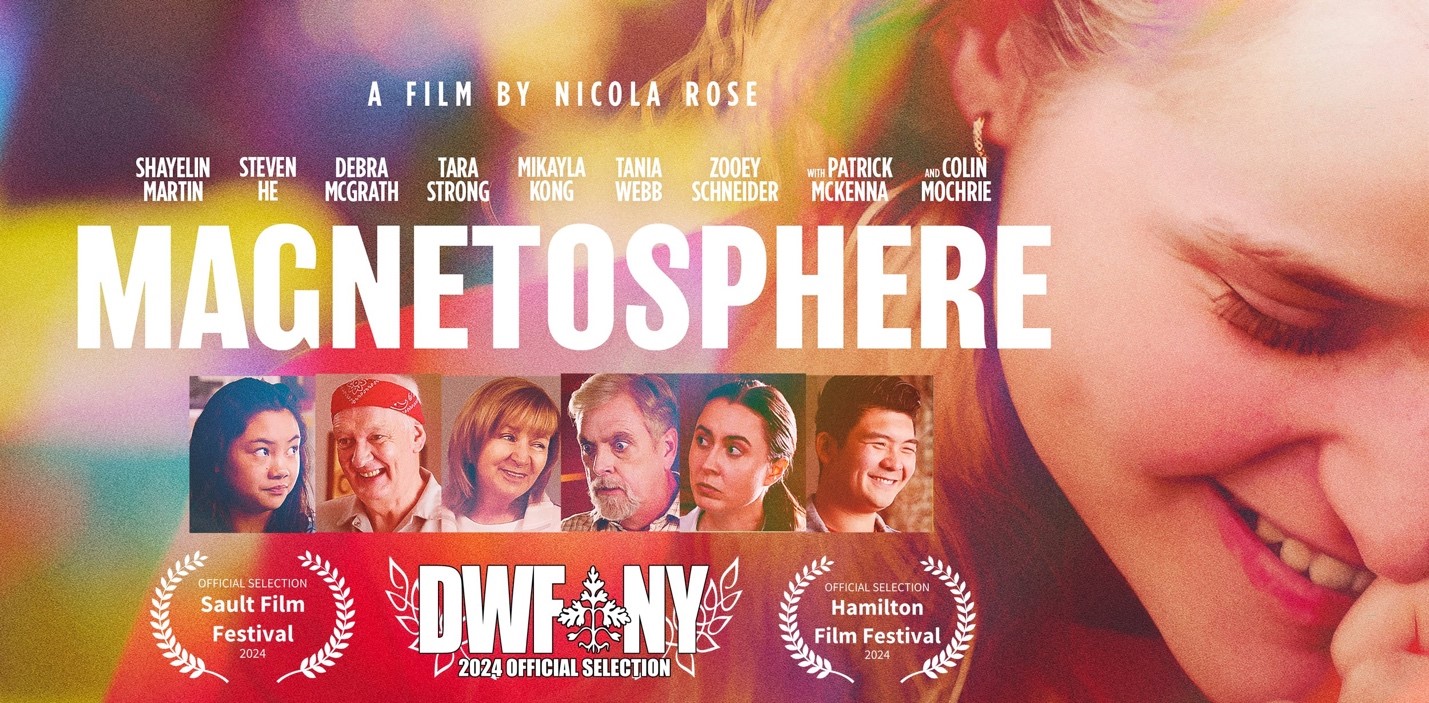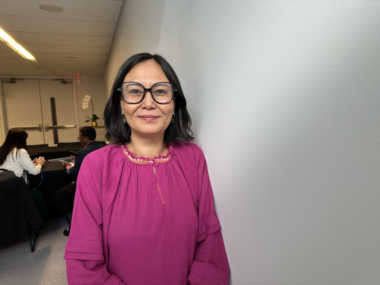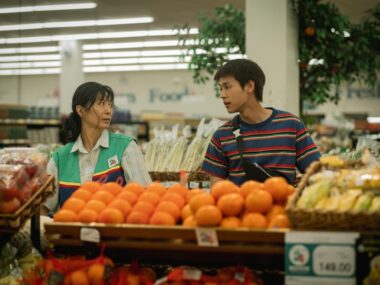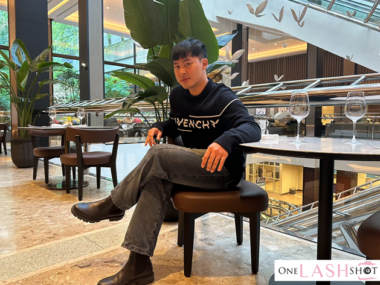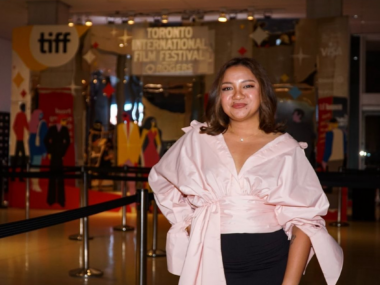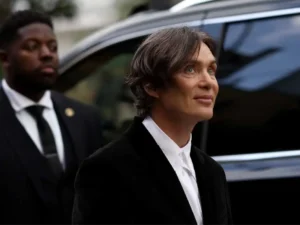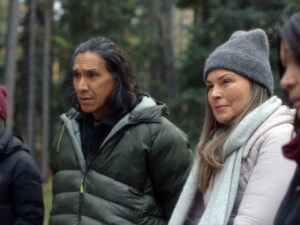Nicola Rose’s journey spans continents and cultures—born and raised in the United States before immersing herself in the rich artistic heritage of France. She earned her bachelor’s degree from Columbia University and went on to complete a master’s at Université Paris III Sorbonne-Nouvelle, becoming fluent in both English and French along the way. Since stepping behind the camera in 2015, Nicola has crafted a distinct cinematic voice, culminating in her debut feature film, Goodbye, Petrushka (2021). The film made its dazzling world premiere at Los Angeles’ Dances With Films festival in 2022, captivating audiences and critics alike. It went on to claim multiple accolades across the indie festival circuit, including Best Feature and Best Comedy, cementing Nicola’s status as a rising talent in the independent film scene.
Her latest feature film, Magnetosphere, tells the story of 13-year-old Maggie, who’s navigating the whirlwind of first crushes, a daunting new town, and the rollercoaster of adolescence—all while uncovering the extraordinary gift of synesthesia, a rare condition that lets her see sounds, hear colors, and experience the world in a kaleidoscope of senses. Actress Shayelin Martin, best known for her performances in The Boys (2019) and Wild Goat Surf (2023), takes center stage as the spirited 13-year-old Maggie. Sharing the screen with her is a stellar cast including Steven He, Tara Strong, Colin Mochrie, Patrick McKenna, Debra McGrath, and Mikayla Kong, bringing this unforgettable story of the influence of synesthesia to life.
One Lash Shot explored the insightful perspectives of Director Nicola Rose and Actress Shayelin Martin, as they thoughtfully addressed and challenged the prevailing stereotypes associated with synesthesia and the autism spectrum.

What inspired the story of Magnetosphere? Was there a specific moment, article, or personal experience that sparked it?
Nicola: You know, the origin story is basically that I was very interested in synesthesia. I didn’t even quite remember what it was called at the time. I was like, “Oh, I think it’s syn-something—the thing where your senses are combined.” I have people in my family who have it. I don’t have it myself, but I did experience it as a child.
The thing is, so many people go through it without even realizing it. You might just assume that the days of the week vaguely have colors, for example, but you don’t think much about it. Nobody walks around wondering, “Is it weird that I have this?”—unless it’s a very extreme case of synesthesia.
We had to lean into the more extreme side for the movie. For instance, there’s a scene where Shayelin gets sick in class because the images she’s seeing turn into unpleasant sounds, and they all combine until she throws up. That actually happened to someone. It’s a real experience someone described to me, and I did my best to make it feel authentic.
It’s the least believable moment in the film, but it’s absolutely true. Maybe the specific details—like the formal elements of art—aren’t exact, but the sensation was similar. What’s interesting is that no two people experience synesthesia the same way. One of our consultants on the film actually said, “What the hell is this? I don’t understand that scene.” But someone else totally related to it. And that’s the thing—people don’t always understand each other’s experiences with synesthesia.
Some people see certain objects as blue. Not everyone sees auras around people. But ultimately, when you’re writing or directing with limited resources—as all indie films do—you focus on the visual and auditory. There are people who have lexical-gustatory synesthesia, which I learned about while making the film. That’s where you taste words.
The problem with that is, at least as far as I can figure out, you can’t really depict that on film—at least not in an interesting way. So, all the sparkles Maggie hears, the music she sees, and the auras around people—that was the clearest, most direct route to say, “Hey, this is what synesthesia is like.”
What exactly is synesthesia? Is it part of the autism spectrum?
Nicola: Yeah. Well, I don’t want to say comorbid—that sounds so negative—but it is comorbid with autism. A lot of people with autism have it. I’ve been low-key lurking in these Facebook groups and stuff—well, I’m not low-keydoing it anymore since I’m now promoting Magnetosphere! It’s coming out July 22nd. Everyone who’s neurodiverse or autistic should watch it.
I don’t know that synesthesia is a kind of autism—I don’t think people would say that. But I do think it’s a form of neurodivergence. It’s a type of neurodiversity, and people experience it as one of many things. It’s also very comorbid with ADHD.
How did you work with the actors to cultivate that sense of inner gravity and emotional tension on screen?
Nicola: I love working with children. Not that Shayelin is a child, but I do really enjoy working with young actors because they tend to be incredibly raw. I actually choose actors like that on purpose, especially since I usually have a lot of options during casting.
There are often too many people who would be great for a role—like, usually seven who could all do it well. Any one of them would be a solid choice.
But anyway, getting back on topic—people have asked me, “Why in the world would you work with children? Don’t do that!”But honestly, it makes my job so much easier. I find that all good child actors can connect to emotion really quickly. Then, occasionally, there’s something that’s weird for them—something they don’t quite know how to do. So, I’ll say something like, “Okay, follow my finger—it’ll look like you’re glancing over there uncomfortably. Just be uncomfortable and follow.”Sometimes it’s as weird and simple as that.
There are scenes in the movie that are literally just someone following a finger. You have to think on your feet. But honestly, that’s true for older actors too.
Shayelin, you play the 13-year-old Maggie in this movie. How did you prepare for the role?
Shayelin: I did some research on synesthesia, and actually, before we started filming, I watched Nicola’s first film, Goodbye, Petrushka, just to get some insight—kind of like research—to see what her style is all about and everything.
There’s a theory that everyone is born with synesthesia. I don’t think I have it, but there are certain things that come to me—like, for example, the days of the week having colors. That’s just in my head, and it feels totally normal to me.
Shayelin, by the end of the film, you turn 14, reconcile your friendship with Wendy, and look forward to a happier future. What was going through your head while filming those scenes?
Shayelin: I was really just thinking about Mikayla. I was focused on being in the moment with her since we’re good friends. The thing is, with those scenes, it honestly wasn’t too personal—it was just a scene. I didn’t have thoughts like, “Oh, is she going to be uncomfortable after this?” or “Am I going to feel weird about it?” because it’s all just pretend. I was just thinking about the scene, honestly.
Nicola: I feel like that’s the best approach—because you kind of have to be the other character as well as your own.
Can you talk about how color played a prominent role in this movie?
Nicola: I really like films that are colorful. I love playing around with color—figuring out what combinations can create an unusual landscape or a memorable scene. A lot of that actually stems from clothing choices.
For example, before we shot the film, during pre-production, I spent a lot of time on Zoom with Hanna Ellis, who’s an excellent costume designer. She would show me wardrobe options for Maggie, or Wendy, or someone else, and that would actually influence how I spoke with our production designer, Janessa Hitsman—who was equally wonderful. I’d say something like, “Okay, one of them is going to be wearing green, or one of them is going to be in red—what can we do around that?”
Sometimes the location of a scene would change last minute. There was one rainy day where the girls ended up having their argument in the car instead of wherever we originally planned. But it actually turned out to be a great palette—I liked it. I think I even adjusted their outfits a bit once I realized, “Oh, they’re going to be in front of gray seats now instead of the original background.”
How was your experience working with Steven He and the rest of the cast?
Shayelin: Really funny. Everyone was really funny. You’ve got Steven He, Colin Mochrie, Patrick McKenna—the three of them literally just bounce off each other. It’s hilarious to watch.
They’re like a little ecosystem of fun. I don’t even know what the right word is. I just love that ecosystem of funny. And Mikayla—she’s a really good friend of mine. We’re pretty close.
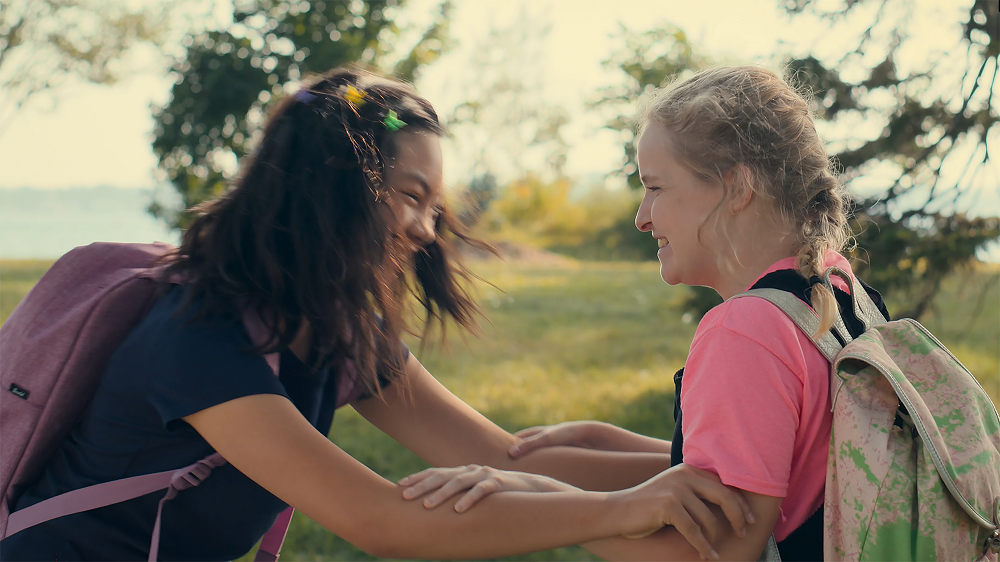
Nicola: Making such besties on that set, which I love. I honestly didn’t know it would turn out like that. I thought this could go either way. You might have hated each other, or it could’ve been awkward because of the age difference—I think she’s three years younger, right? She was just 12 when we shot the film, and it was her first big role. But she absolutely stepped up to the plate.
My experience working with the cast was very different from Shayelin’s. She actually got to hang out with them between takes, while I—if you look at any behind-the-scenes photos—I’m always at a monitor, not really interacting with the actors until the moment I have to be fully present with them.
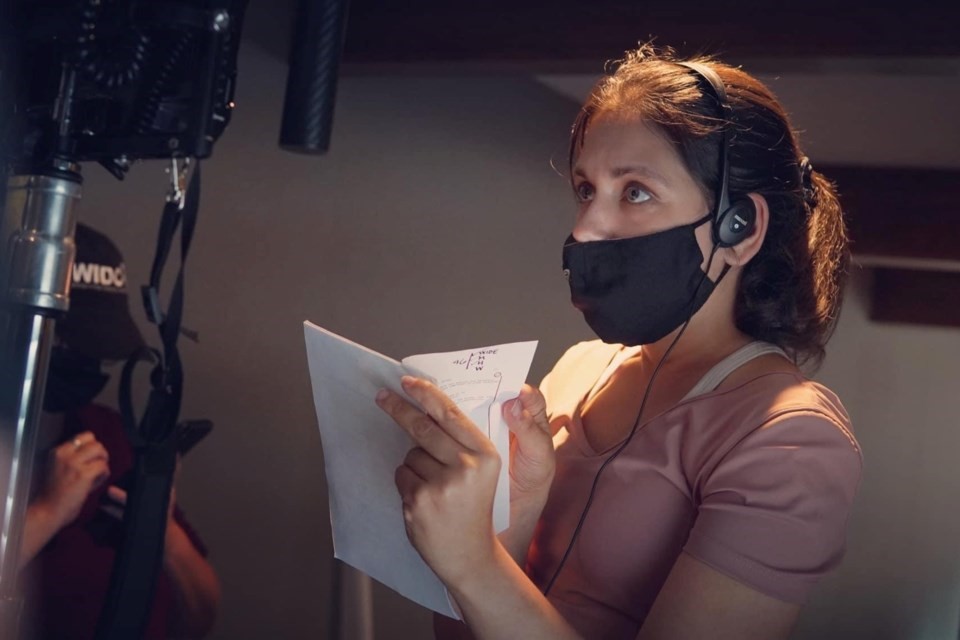
As for the three men, they are truly some of the funniest people I’ve ever worked with. Tara Strong is also incredibly funny, but she wasn’t on set—she voiced her character later in post-production. Debra McGrath is another one who improvises beautifully. Some people have even said her character—the art teacher—is their favorite in the film, which I totally agree with.
There are already a few reviews that say things like, “I wish I’d had a teacher like the art teacher!”Debra is honestly one of the most empathetic people I’ve ever met. I joke that she can look at you and tell if you’re running low on paper towels.
Her husband, Colin, is just as empathetic. Maybe he doesn’t have the paper towel radar, but he absolutely knows how everyone’s feeling at all times. I think that’s a huge part of what makes him so funny—he’s incredibly perceptive. He’s also very quiet and focused, except when he’s with Patrick. They’ve been friends for something like 40 years. When they’re together, Colin totally lights up and bounces off Pat’s energy.
Patrick can go from being laser-focused on set to flipping a switch and suddenly becoming this manic, brilliant comedic character. He uses his own neurodiversity—specifically his ADHD—to bring so much authenticity to that performance. It’s amazing to watch.
Steven He—I just wish we had more opportunities to showcase his comedy on screen because he is so naturally funny. He creates his own content and basically became famous for writing sketches parodying his parents and cultural expectations. But in this film, we get to see a side of him that nobody usually sees. He has a very dramatic scene with Shayelin near the end of the movie, and I remember showing it to my mom before anyone else saw it. She said, “Oh my God, he’s so good in this scene!”And Shayelin is too. It’s incredibly tense, and both of them nailed it.
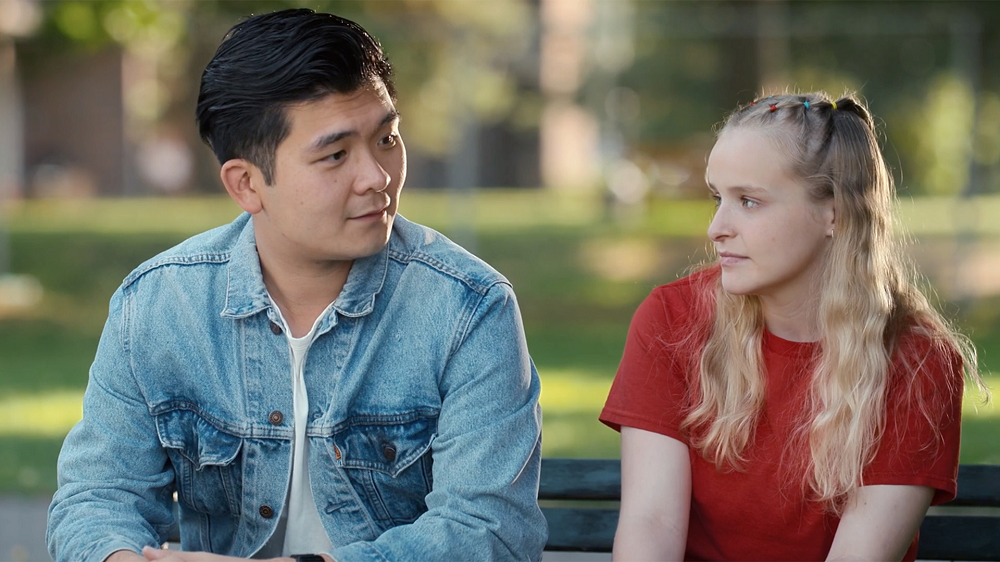
That’s one of the many reasons I hope people watch this film—because you get to see these actors doing things they’re not usually known for. Steven sings. He gets emotional. Colin plays a character who isn’t improvising for once. He and Pat had never done a full-length scripted project together before, and according to Colin, this was their first.
And I just wish more people outside of Canada knew about Pat and Deb. Up here, everyone recognizes them instantly. In the U.S., people are like, “These actors are amazing—where did you find them?”
This story is a powerful reminder that neurodiversity isn’t something to fix—it’s something to celebrate and embrace. What do you think the human approach to this topic should be?
Shayelin: Just treat people the same way you treat everyone else. I was diagnosed with ADHD when I was younger. And I’m not like the angry ADHD stereotype—I’m hyperactive. But honestly, it’s not that hard. Just treat people like everybody else.
This is the thing that really gets me—my mom is a teacher, and she’s had so many students with learning disabilities. But their parents often say things like, “I just want to fix them.” And it’s like, they’re not broken. What are you talking about? You don’t need to fix your kid. Just accept them. Support them. Let them be who they are. The idea that there’s something wrong with them—it’s just wrong.
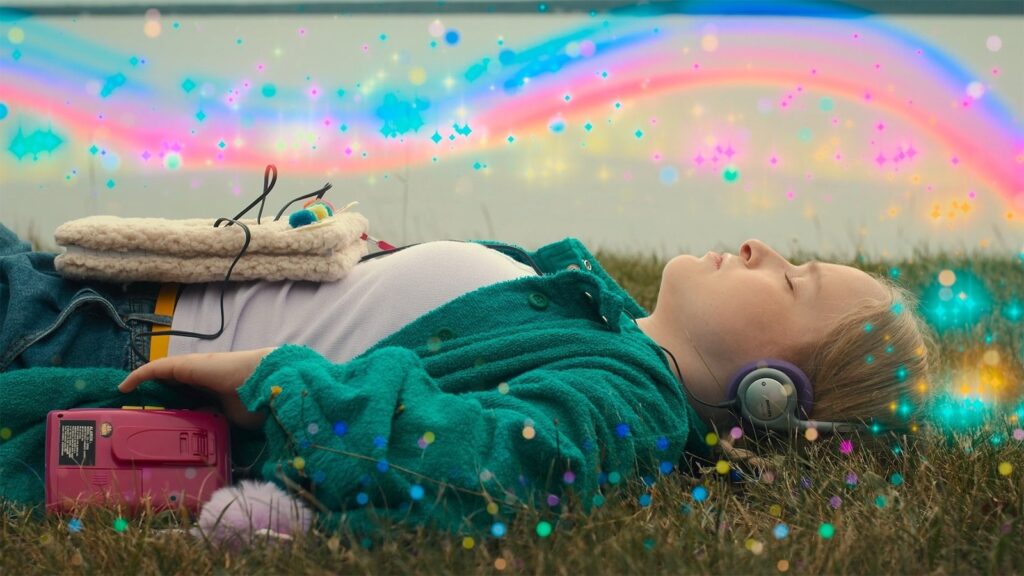
Nicola: Honestly, I have a couple of neurodivergent traits myself. Mainly ADHD—it came on in adulthood, so I’ve been learning how to navigate that. But when I think back to my childhood, and even to others around me who were different in some way, it’s wild how badly people were treated just for not fitting into a narrow mold.
Back then, we didn’t even have language like “on the spectrum.”The idea of a spectrum didn’t exist 20 years ago when I was a teenager. So, I really hope that, as a society, we’ve become more compassionate. I hope we’ve learned to view neurodiversity as something that enriches humanity—something that makes people more complex and interesting, not something that needs to be squashed or erased.
Shayelin: Yeah—honestly, the world would be so boring if people didn’t have all these different ways of thinking and being. There are so many actors and actresses who have ADHD or other forms of neurodivergence. Imagine if they didn’t. Imagine if they had been fixed or made to hide who they really are. It would take away everything that makes them unique. Let people be who they are—it makes the world better.
Nicola: Exactly. If you look at my last film, Goodbye, Petrushka—it was my debut feature, so it’s a very unapologetically indie movie. And the funny thing is, I didn’t realize I had made a film about an autistic character until after it came out. I started getting reviews and comments from autistic people saying things like, “Thank you for this,” or “This really spoke to me.”
The film follows a 19-year-old girl who’s extremely impulsive, completely obsessed with puppets, and very fixated on one man—sorry, that ispart of the plot. But she’s not really an adult yet. She’s in that in-between space, and it resonated with people who saw themselves in her. It wasn’t something I consciously planned, but I think it shows how many stories are already out there about neurodivergent people—we just don’t always label them that way.
I’d love to tell more stories like that—especially ones about late-diagnosed adults. That would be such a cool movie to make. I’m just not quite there yet as a filmmaker. But it’s on my list.

